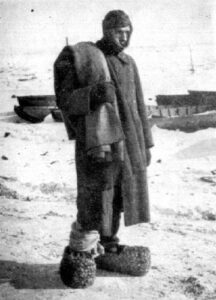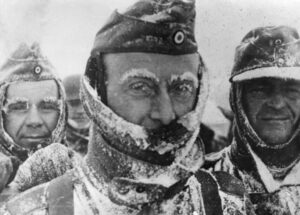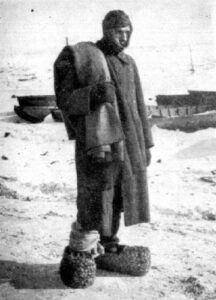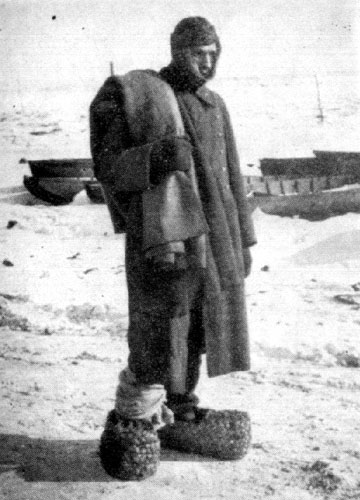


World War II was not only characterized by fierce battles, but also by extreme weather conditions that placed additional strain on soldiers at the front. The brutal winter on the Eastern Front, in particular, became one of the greatest challenges for the Wehrmacht. Many German soldiers were ill-equipped for the icy cold, which could reach temperatures as low as -40 degrees Celsius. These climatic conditions were feared as much as the enemy itself.
Harsh reality on the Eastern Front
The photo shows an exhausted German soldier fighting his way through the snowstorm with his MP 40 submachine gun. His face is etched with cold, his helmet and coat covered in snow. Winter uniforms were often inadequate, and many soldiers suffered from frostbite, illness, and hunger. Those who didn’t have warm clothing or improvised protective measures in time risked serious injury or death.
During the 1941–1945 campaign against the Soviet Union, winter often became the Wehrmacht’s greatest enemy. The Soviet army was accustomed to these conditions and was better able to adapt. German soldiers, on the other hand, often had to resort to captured winter clothing or makeshift measures such as wrapping their feet with strips of cloth to avoid frostbite.
The fight for survival
In addition to the enemy and the icy cold, the German troops also struggled with supply problems. Long supply lines were disrupted, fuel and ammunition were running low, and vehicles failed in the cold. Many soldiers were weakened by hunger and disease. Conditions deteriorated increasingly the longer the war dragged on. The battles for Moscow (1941–42) and Stalingrad (1942–43) in particular became symbols of the merciless survival in the winter hell.
The soldiers often had to sleep in makeshift shelters that offered little protection from the cold. Starting fires was risky, as it could alert the enemy to their position. Moreover, there was often barely enough wood to keep a fire going. Many sought shelter in abandoned buildings or captured Russian bunkers, but even there it was bitterly cold.
Psychological stress and exhaustion
In addition to the physical strain, the psychological strain was also enormous. The constant fight for survival, the loss of comrades, and the hopelessness of the situation took its toll on the soldiers’ nerves. Many suffered from extreme exhaustion, lack of sleep, and fear. The harsh winter made recovery almost impossible. Even simple tasks like eating or cleaning weapons became a challenge because everything was frozen.
Especially in the final years of the war, 1944–1945, when the Wehrmacht was increasingly forced onto the defensive, winter became an insurmountable obstacle. Retreats in icy cold, often on foot and carrying heavy packs, claimed thousands of victims. Many soldiers suffered frostbite, and some died of exhaustion before even encountering the enemy.
Meaning of the photo
This image is a striking testament to the harsh conditions under which the soldiers fought on the front lines. It shows the reality of war—not just armed combat, but also the struggle against nature and one’s own limitations. Images like these remind us that war was not decided solely by weapons, but also by the ability to survive under extreme conditions.




